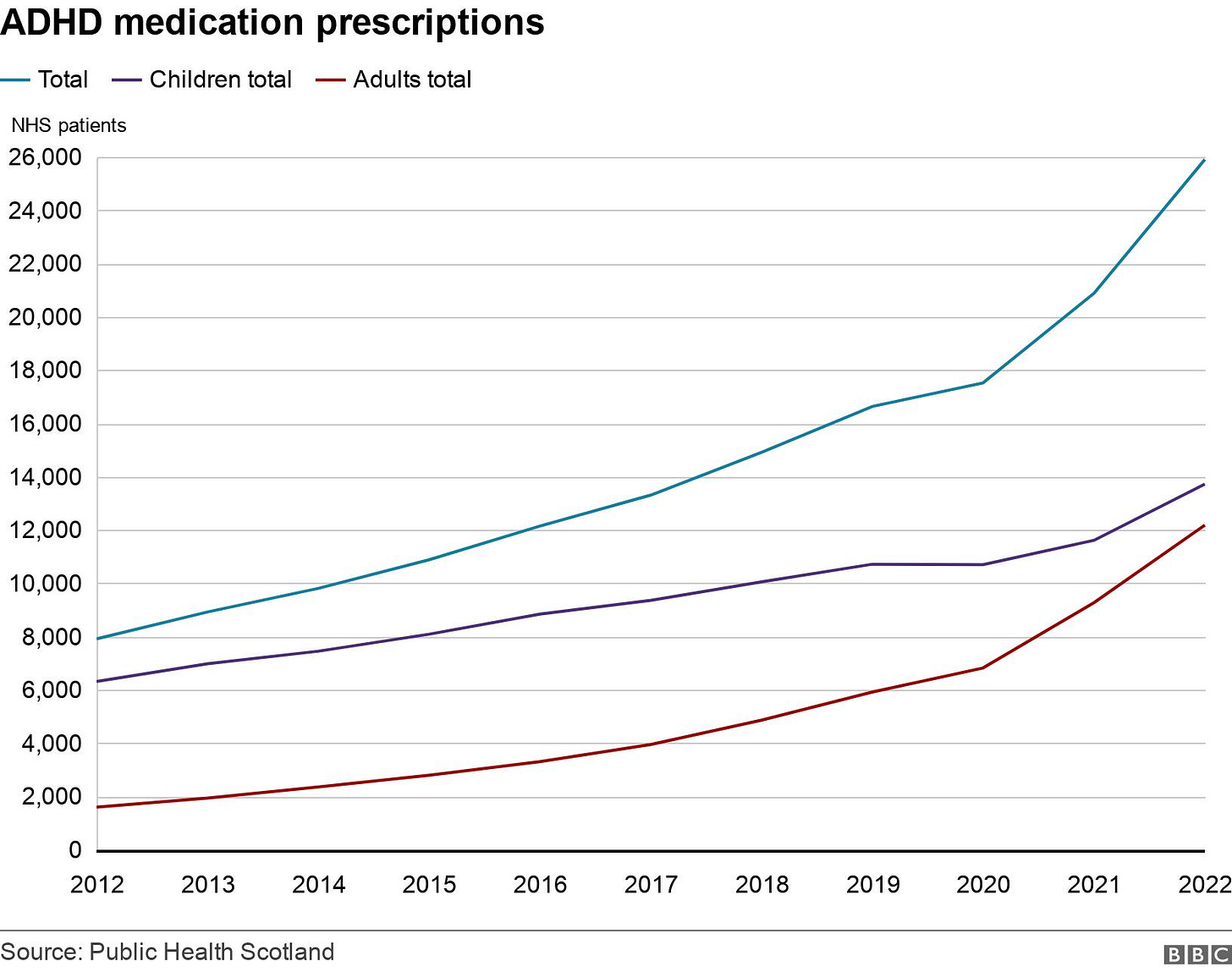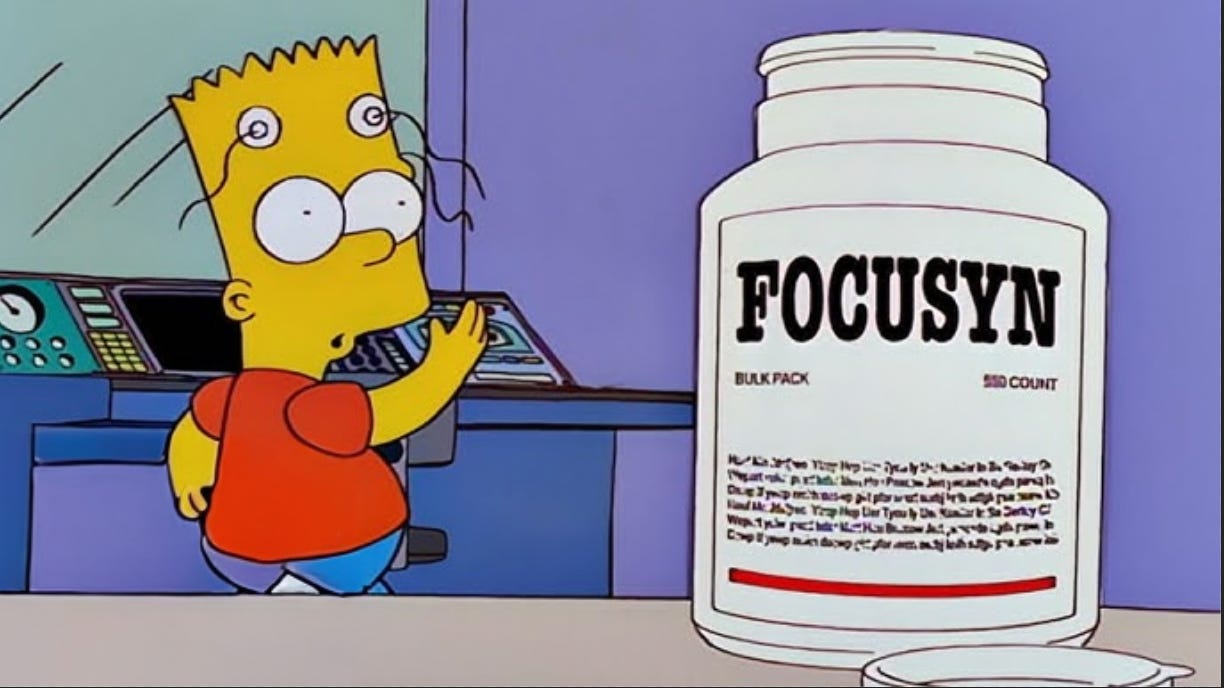What if you procrastinate because your imagination sucks?
An overlooked exercise for tackling procrastination and ADHD-like symptoms
The use of ADHD drugs has tripled in the UK between 2012 and 2022.
Lately, this set of graphs showing that young adults becoming less conscientious, less agreeable, less extroverted and more neurotic is going viral.
The author of the graph says that a plausible driver behind these changes are digital distractions. In specific, conscientiousness is going down because smartphones and all their forms of easy entertainment make it easier to get distracted, harder to commit to plans and more tempting to just blow off real-life commitments.
Lowered conscientiousness already suggests increased procrastination, but I’d bet imagination is on a dramatic decline as well.
What if the real issue with people suffering from ADHD or frustrating procrastination is that they just have terrible imagination? That is, what if the solution was learning how to paint a vivid mental image of the future?
Let me lay out why and how Episodic Future Thinking reduces procrastination and potentially even some ADHD symptoms.
Why do people procrastinate?
Two weeks ago, I released an article titled There is only one way to stop procrastinating that is a deep dive into why you’re far more likely to feel like doing something once you’re already doing it. That is, waiting for motivation or inspiration to strike is a losing strategy from your brain’s perspective.
A great way to not feel like doing something is to …not be in the process of doing it.
Easier said than done.
Let’s dig more into why people procrastinate so we can tackle it more effectively.
One key reason for procrastination is “future discounting.” Simply put, we don’t value rewards that come later in the future compared to rewards that come more quickly. Most people are likely to accept $50 right now compared to $75 a week later.
Logically this makes sense, all sorts of things could happen in a week. In a week, you might not even want to play that game that is on sale for $49.99, you might not want that overpriced hamburger and drinks you’re craving right now and so on. Maybe the guy who is offering you the $50 or $75 will change his mind and not even give you the $75 a week later. You noticed he’s got cauliflower ear so he probably does Jiujitsu, so maybe he’ll be busy dealing with his torn rotator cuff and unable to give you the $75 a week later.
A very clever 2024 study aimed to properly test out this idea that future discounting leads to procrastination.
The authors realized most of the previous studies trying to investigate procrastination’s relation to future discounting didn’t actually track people’s procrastination in real time and the method used to test future discounting didn’t have real world consequences.
They measured real-world procrastination by doing the experiment on students who were enrolled in the Introduction to Psychology course at New York University. Enrolled students were expected to participate in research studies for a total of 7 hours before the end of the semester. So, the researchers could simply track how much progress these students were making on these 7 hours at what point in time. That is, were they consistently doing a little bit at a time or saving it all for the last minute?
Then, to check the students’ future discounting habits, they didn’t have the students do some questionnaire about whether they would theoretically accept $30 now or $40 bucks in a month. Instead, they were receiving actual money in the form of Amazon gift cards. That is, if they said they’d prefer to wait for a bigger payout, they would actually get a more expensive Amazon gift card.
They concluded that the effect is indeed real:
We found a positive correlation between individuals’ degree of future reward discounting and their level of procrastination, suggesting that temporal discounting is a cognitive mechanism underlying procrastination.
That is, the more someone believed that rewards in the future were less valuable, the more likely they were to procrastinate.
Valuing the future less = more procrastination.
How do we make the future more valuable?
One way to make the future more valuable is to, well, make the future feel less like the future. You need to make it closer.
You can combat future discounting by making the payout, the reward, feel closer.
Clinical Neuropsychologist and ADHD expert, Dr. Russel Barkley, summed up ADHD like this:
“It’s always now. ADHD is, to summarize it in a single phrase: time blindness. People with ADHD cannot deal with time. That includes looking back to look ahead to get ready for what’s coming at you. So the individual with ADHD is kind of living in the now. Wherever the now goes, they are being pulled along by the nose wherever it goes.”
He then gave the example of a man whose wife was pleading with him to help his ADHD husband. The wife told Dr. Barkley a story about how her husband who went out to mow the yard but realized that it needed gas. He got his fuel can, put it in his truck and went down the convenience store. He ran into his buddy there and he invited him to go fly fishing, so off the two of them went in the husband’s friend’s truck. After their 6-hour fishing trip, they were very tired and thirsty, so they stopped off at the pub for some beers. Within an hour, the state police had found the husband’s truck still running with an open gas can at the convenience store. Eventually he made his way home at 4 P.M.
“Do you see what happens? It doesn’t matter what your plans were, what your goals were, the now is more compelling than the information you’re holding in mind and you will get pulled along by the now. You are time blind. …or technically, to be more accurate, [ADHD creates] a nearsightedness to the future. …the further out the event lies, the less they are capable of dealing with it. This is why everything is left to the last minute. They only deal with last minutes, that’s all they perceive, that’s all they deal with, that’s all they organize to, and so their life is a series of one crisis after another, all of which were avoidable because people prepared and they didn’t.
So, why doesn’t everyone have ADHD?
Why does anyone have the ability to ignore the appealing things happening now in the environment?
Well, of course humans have the ability to imagine the future.
We can imagine a future we want and then we can run a simulation of what behaviors are necessary for arriving at that future.
What if ADHD is a matter of practice?
What if the real issue with people suffering from ADHD or procrastination is that they just have terrible imagination?
That is, what if the solution was learning how to simply paint a vivid mental image of the future?
The use of ADHD drugs has tripled in the UK between 2012 and 2022.
ADHD is a complex disorder that's thought to involve complex tweaks to the brain like altered dopamine transporters and receptors, but we might be able to conceptually simplify this down to just “weak imagination.”
A 2015 study in healthy children found that the kids who were able to imagine a future more vividly did less future discounting and so we should expect that they are the type to procrastinate less. That is, they valued the future more.
As explained in a 2023 paper:
Adults with ADHD tend to underestimate the magnitude of future punishment and more highly estimate immediate rewarding stimuli.
As we saw with the man who went fishing, the future was worth basically nothing to him compared to now. The future was such a wispy, flaky, hollow thing that he couldn’t even hold it in his mind long enough to fuel his lawnmower.
Indeed, people with ADHD having a crappy “prospective memory,” that is, being crappy at ‘remembering to do the thing you planned to do,’ is suggested to be what links ADHD to increased procrastination.
Every now and then I’ll slip into a groove of looking at too much scrolling on my phone. Eventually my focus decreases, procrastination increases substantially and I wonder if I’d fall into the “ADHD” category. Many times my lack of productivity would come down to simply forgetting what I needed to be doing.
I might find myself sipping my coffee, checking my email and then reading an article about hypobaric hypoxia training. Then I’m doing a search to see what the hell that looks like, then I’m searching if there’s any gyms in Tokyo that provide that, then trying to figure out their pricing structure. I’m calling them to see if I can go that day, then while I’m on hold I finally realize I just spent 30 minutes not writing a script for the video for my main channel. It wasn’t like I was avoiding writing, I just forgot about it and/or couldn’t vividly imagine how long this investigation into hypobaric training would last.
Psychologist Dr. Marie Rebetez writes that the issue with procrastinators may be that simply have more difficulties with imagining future scenarios
Having done several meditation retreats, it’s surprising how much you can train your brain’s ability to do certain fuzzy mental tasks like focusing on the breath or even using a specific emotion as a meditation object for hours at a time.
So, why wouldn’t we be able to practice our ability to vividly imagine the future?
With a more vivid mental picture of the future, this should theoretically reduce future discounting, increase prospective memory and reduce procrastination.
The power of Mental Painting: EFT
It's 1:30 AM in Beijing and you're staring at a blank page on your old Lenovo laptop as you chew on a salty sunflower seed. The thought of even trying to get any words on the page makes your shoulders and neck tighten up. Suddenly you have the brilliant revelation that you have a phone in your pocket. You could escape this frustration with a couple scrolls.
After all, a couple scrolls couldn't hurt right?
You bargain with yourself: “OK just ten scrolls and then I'll get to work, I promise. No cap, none.” You put another sunflower seed in your mouth and excitedly commence scrolling. As you open the settings panel to raise your phone to max brightness, you imagine how satisfied and ready to work you’ll be once the ten scrolls are up.
One scroll... two scrolls... eight scrolls... twelve scrolls... fifteen scrolls... twenty three scrolls... thirty one scrolls.
You finally come to your senses and realize you have spent almost twenty minutes scrolling. You hang your head in shame, countless sunflower seeds dribbling out of your mouth.
"Why am I like this... I work at the neuropsychology and applied cognitive neuroscience lab. Why can’t I control myself?"
You suddenly hear a voice. You instinctively turn your head to look for the intruder in the dark lab. Who could it be? Everyone had to have left the lab hours ago. You realize it’s a voice in your own head. You can hear it so vividly that you can practically feel the speaker’s breath.
The voice says very clearly: "Remember your training. Use the EFT."
You realize what you must do.
You pop open the voice note recorder on your phone and begin talking. You paint a vivid scene of the days following completing your paper. After writing the paper, you’ll wake up in the morning, reborn. You take a shower, feeling like you can’t even get wet, like the water can’t penetrate a thick film of confidence covering your body. As you walk down the sunny street to the lab, you notice women are whipping their heads to get a good look at the new you. You burst through door to the lab and all your colleagues stop what they’re doing. You can’t even hear yourself saying “thank you thank you” because their clapping drowns out your voice.
Then, the scene changes.
You're sitting on the smooth leather arm chair on the Conan O'Brien set and you can practically feel the huge space between the stage and the huge audience. You're surprised at how tall Conan is, even while sitting down.
Holding your paper up to the camera, Conan introduces your work, praising you as the man who cracked the code of human psychology. Conan pauses for a second and then looks at Dave the camera man. He turns to the audience:
“Ladies and gentleman, let’s give a big round of applause for Dave the Camera man. He’s been with us for 10 years. Similar to Pedro Pascal, Dave suffers from anxiety which is conveniently cured by touching women. Let’s see… you there, ma’am… would you mind standing uncomfortably close to Dave? He’s gonna need you. Unfortunately Dave’s anxiety is about to spike because starting today he is fired …for not zooming close enough on this amazing paper!”
A worried Dave cracks a big smile. The audience bursts into laughter.
Conan says with a smile: “Do your job, Dave! Zoom in! This paper is gonna change the world!”
After 10 minutes you hit "done" on your voice note to cap off your visualization. Something has shifted in your mind. You can practically feel the future. It's as real as the sunflower seed rolling back and forth between your thumb and index finger. You sit up straighter. You can feel a wave of determination flow up your spine. You suddenly have the motivation to clean up all those sunflower seeds you spilled. As you're taking the sunflower seed-filled napkin to the trash bin, the perfect title for your paper pops in your mind. The title is more exciting and compelling than any of those thirty one reels you just watched: A meta-analysis of the effects of episodic future thinking on delay discounting.
Your 2021 meta analysis was published in the Quarterly Journal of Experimental psychology. It broke down 47 different studies on episodic future thinking (EFT) and future discounting. They found that the type of EFT that had the people vividly imagine positive future scenarios had an effect size of 0.64. This is a very meaningful effect that translates to actual behavior change.
To put that into context, an effect size of 0.0 means it's a complete coin-flip (50/50) whether say a drug does any better than placebo. Daily use of antidepressants have consistently produced an effect size of only 0.30 for decades. EFT had a 0.64 effect size. The effect size of being male on height is 2.0, compared to being female.
Other papers note that Episodic Future Thinking has repeatedly proven successful in modifying delay discounting behavior and has been described as one of the most promising strategies for reducing future discounting.
We should expect it to also significantly reduce procrastination.
A more recent 2023 review says EFT is so powerful it has promising even for people trying to combat substance use disorders.
Simply put, episodic future thinking is a specific method of deliberately visualizing the future.
So, how do you do Episodic Future thinking?
It’s quite simple, but I doubt it’s something you’ve ever actively practiced.
Think of 5-10 future events you’re looking forward to with different time horizons (i.e 1 month out, 6 months out, 1 year, 5 years, 1 years). They should have some relation to certain goals you have or at least be positive events.
Write down a “tag” for each one.
・ “In 6 months, I’m vacationing in the Belgian countryside.”
・ “In 1 year, I’m getting married.”Open the voice memo/voice recording app on your phone.
Record yourself imagining and speaking about the details of that event. Make it as vivid as possible.
・Who’s with you? Where are you? What are you doing? What can you see / hear / smell? How do you feel?
・As an example, if it’s your wedding: Who’s your best man? Who do you see filling the chairs in front of you during the ceremony? Do you smell wooden notes of an old church or do you feel a cool breeze because its outside? How does the fabric of your suit feel on your skin?Now pick out and write down the most vivid “cues” from that visualization session. For example:
・Tag: “In 1 year, I’m getting married.”
・Cue: “I feel a warm wave of pride in my chest as I look around a room filled with family and friends smiling at me; I can feel the high quality fabric of my suit hugging a fit body that is 30 lbs lighter.”
Using the cues:
As part of your morning routine: Pick one random cue you’ve written down, set a timer for 60 seconds, close your eyes, and reimagine the scene until the timer rings.
When you’re faced with a temptation or trying to muster the willpower to do something productive: Pick a relevant cue, imagine the scene for 30 seconds, and then make the decision to give in or not.
Schedule other times during the day you can spend visualizing the cues. Every day, do a total of 5 minutes of practicing visualization. Continue this training for at least 2-4 weeks.
If visualization seems like woo-woo, you might suck at it
Elite climber Alex Honnold, Novac Djokovic, Michael Phelps, Manchester United’s Wayne Rooney, coach Pete Carroll of the Seattle Seahawks, and coach Phil Jackson of the Chicago Bulls and LA Lakers all include visualization as an important component of their practice.
A 2013 trial on Tibetan tummo meditators titled Neurocognitive and somatic components of temperature increases during g-tummo meditation: legend and reality documented the dramatic effects of a specialized visualization technique on body temperature.
You may have heard of the Wim Hof breathing method which is very similar to that of the breathing technique used in tummo. This study noted that when monks used the “Forceful Breath vase breathing” technique, they could raise their body temperature to 37.45°C. It was only when they included the visualization technique along with it that they could consciously override their autonomic nervous system push their body into fever territory, all the way to 38.3°C.
Tibetan meditators are said to be able to use this self-heating technique to dry soaking wet sheets draped around their body while outside in the snow.
The tradition of Tibetan Buddhism called Vajrayana includes visualization-based meditation techniques like “deity yoga.” In deity yoga, one is to visualize a very complex scene: one where they are in the center of the “celestial mansion of the maṇḍala.” They are also to imagine that they are surrounded in all directions by other male and female buddhas, bodhisattvas, vajra ladies, and so forth.
This is something that takes years of practice to get down.
Professor Maria Kozhevnikov has studied practitioners of this deity visualization technique and found that they achieved “dramatic improvements in visual memory and spatial skills.”
With two decades of fieldwork in remote monasteries in Tibet, Bhutan, and Nepal, Kozhevnikov shared groundbreaking findings from her scientific studies of Vajrayana practitioners. Her experiments showed that during deity visualization meditation, monks achieved dramatic improvements in visual memory and spatial skills, allowing them to exceed a human’s “normal” level of performance.
The point is, visualization is a skill you can get good at.
Maybe you’re already better at visualization than you think, but as Tibetan meditators have proven, the skill ceiling is pretty high.








I have heard about visualisation 20x before and even did a version of the exercises you mentioned. Never before have I seen such a good explanation of why this works. I will 100% be doing this. Thank you, fan of your work! Ps where can I send you a question?
Is scrollsturbation a word?